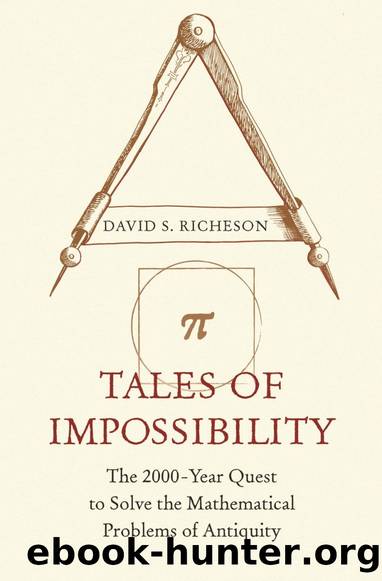Tales of Impossibility: The 2,000 Year Quest to Solve the Mathematical Problems of Antiquity by David S. Richeson

Author:David S. Richeson [Richeson, David S.]
Language: eng
Format: epub
ISBN: 9780691192963
Google: d-csEAAAQBAJ
Amazon: 0691192960
Barnesnoble: 0691192960
Goodreads: 44438361
Published: 2019-07-08T11:29:15+00:00
he states is z = a/ 2 + a 2 / 4 + b 2.
To do so, he uses a compass and straightedge to construct a
right triangle LMN with LN = a/ 2 and LM = b (see figure 15.5).
Then he draws a circle with radius LN and center N and extends
C O M PA S S - A N D - S T R A I G H T E D G E A R I T H M E T I C
241
FIGURE 15.4. Descartesâs method of constructing square roots.
FIGURE 15.5. The segment OM is the solution to z 2 = az + b 2.
NM to O. By the Pythagorean theorem, MN 2 = LN 2 + LM 2. Moreover, MN = MO â NO = MO â LN. Combining these equations we have (MO â LN) 2 = LN 2 + LM 2. Rearranging terms gives MO 2 = 2 MO · LN+
LM 2 = a MO + b 2, which implies that z = MO is the solution to the equation.
Constructible Points and Constructible Numbers
So that we can understand what came next in the investigation of
these problems, it is important to be very clear about what we can
conclude from Descartesâs work on constructibility. Unfortunately, his
Geometry isnât set up in a modern way, with clearly articulated defi-
nitions, carefully stated theorems, and rock-solid proofs. Because we
want to present the conclusions in a way that our path forward is more
clear, in this section we will transport ourselves to the present day and
examine some of the conclusions we can draw from Descartesâs work.
We will do it in a clear, rigorous, and modern fashionânot in the way
Descartes wrote about them.
242
C H A P T E R 15
FIGURE 15.6. Two circles and a line yield constructible numbers 0, ±1,
â
â
±1 / 2, ± 3 / 2, and ± 3.
Although we see lines and circles when we look at a compass-
and-straightedge construction, it is the points of intersection of the
lines and circles that are important. To say in full generality what is
constructible, we assume that we begin with as blank a slate as pos-
sible. We assume that we begin with two points, and we make the
assumption that they are one unit apart (or equivalently, we begin
with a unit line segment). At times, it is convenient to assume we have
a coordinate system; in this case, we assume the two points are ( 0, 0 ) and ( 1, 0 ). (We could even draw the x- and y-axes using the compass and straightedge if we wanted to.) Now, from these we can define two
related notions: constructible points and constructible numbers.
A point P is a constructible point if, starting with our two points, there is a sequence of legal compass-and-straightedge moves (recall
we gave the ârules of the gameâ on page 49) such that P is the point of intersection of two constructed curves (lines or circles). A real number
a is a constructible number if there exist constructible points P and Q
(with P = Q a possibility) such that | a| is the length of segment PQ.
Download
This site does not store any files on its server. We only index and link to content provided by other sites. Please contact the content providers to delete copyright contents if any and email us, we'll remove relevant links or contents immediately.
Harry Potter and the Cursed Child: The Journey by Harry Potter Theatrical Productions(3983)
The Sports Rules Book by Human Kinetics(3597)
Molly's Game: From Hollywood's Elite to Wall Street's Billionaire Boys Club, My High-Stakes Adventure in the World of Underground Poker by Molly Bloom(2974)
A Knight of the Seven Kingdoms by George R R Martin(2635)
Quidditch Through the Ages by J.K. Rowling(2606)
Quidditch Through the Ages by J K Rowling & Kennilworthy Whisp(2585)
How To by Randall Munroe(2492)
Quidditch Through the Ages by Kennilworthy Whisp by J.K. Rowling(2443)
Quidditch through the Ages by J. K. Rowling(2382)
Quidditch Through The Ages by J. K. Rowling(2341)
Stacked Decks by The Rotenberg Collection(2283)
776 Stupidest Things Ever Said by Ross Petras(2279)
The Infinite Retina by Robert Scoble Irena Cronin(2258)
What If?: Serious Scientific Answers to Absurd Hypothetical Questions by Randall Munroe(2177)
Flowers For Algernon by Daniel Keyes(2167)
Beautiful Oblivion by Jamie McGuire(2155)
The Book of Questions: Revised and Updated by Gregory Stock Ph.d(2144)
Champions of Illusion by Susana Martinez-Conde & Stephen Macknik(2080)
Ready Player One: A Novel by Ernest Cline(2080)
